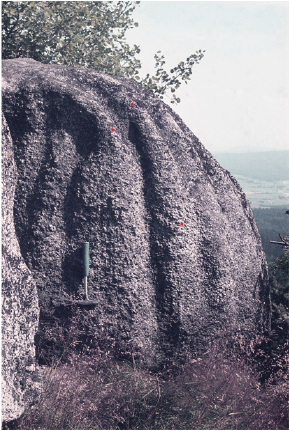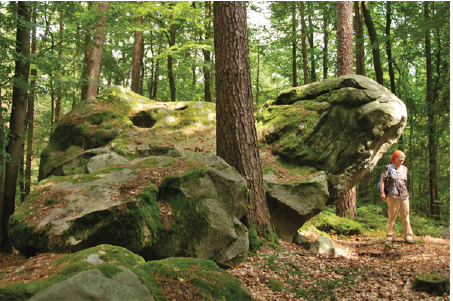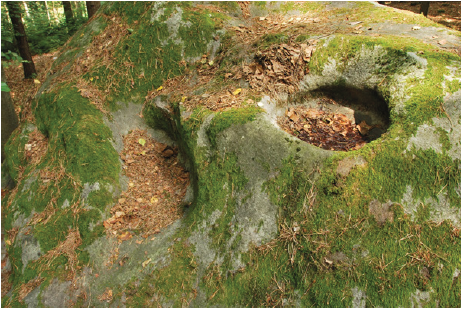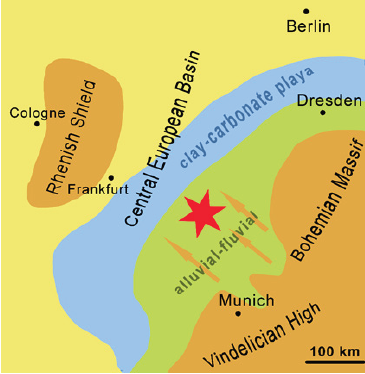- Submissions

Full Text
Biodiversity Online J
Silikarst and Paleo-Silikarst in Southern Germany
Wolfgang Schirmer*
Former Department of Geology, Heinrich-Heine University Düsseldorf, Germany
*Corresponding author: Marcelo Silva Briano, Autonomous University of Aguascalientes, Mexico
Submission: February 10, 2021; Published: September 27, 2021

ISSN 2637-7082Volume1 Issue5
Abstract
This paper is a preliminary record of observations of fossil and surficial silikarst phenomena. The term silikarst is a short form for silicate karst. The term karst was introduced for solution processes and forms in carbonate rocks. It was transferred to similar forms and processes in silicate rocks as silikarst. Silikarst developed at the surface is known from a few silicates rock types in Germany, as from granite (e.g., Waldstein in the Fichtelgebirge), from quartzites (e.g., Cretaceous orthoquartzites in the Northern Franconian Alb) and from sandstone in various areas of Germany (e.g., Lower Triassic Buntsandstein). Paleo-silikarst occurs in non-carbonaceous sandstone (e.g., in the Middle Triassic sandstone landscape of the Steigerwald in Northern Bavaria).
Keywords: Granite; Quartzite; Sandstone; Sandstone decay; Weathering pockets; Chromic cambisol
Introduction
Silikarst is used here as a short term for silicate karst. This phenomenon described since many years shows similar features to those recorded from carbonate karst, after which the name karst was given by [1]. Despite many authors use the prefix pseudo-for silicate karst appearances [2,3], other authors accepted silikarst as own true karst phenomenon. White et al. [4] named it “Quartzite karst”. Also, sandstone karst is used [5,6] and silicate karst [7]. As karstification occurs in nearly all silicate rocks there is high agreement to consider silicate karst as true karst phenomenon though silicate karst differs in many respects from carbonate karst [8-10].
Silicate karst is proved to be bound to silicate rocks like sandstone, quartzite and many other silicate rocks. The main difference to carbonate karst is the intergranular dissolution of quartz, which decreases the strength of the rocks [10]. Silikarst is widely spread with well exposed karst forms, best visible for example in Australia [8] and Africa [11,12]. In Germany, it occurs only locally, e.g., as tube-shaped caves in the western Pfälzer Wald up to good 40m in depth [5]; (Figures 1-5). This paper deals with some new surficial and buried paleo-silikarst phenomena in southern Germany (Figure 1).
Figure 1: Location map of southern Germany. Red dots mark the locations 1-5 described in the text. 1=Waldstein/ Fichtelgebirge.
2=Steinberg/Fränkische Schweiz;
3=Höchstadt/Steigerwald;
4=Katzenstein/Northern Eifel;
5=Pfälzer Wald. Background map: Westermann Schulbuchverlag GmbH.

Figure 2: Karren in granite. Waldstein (877m a.s.l.)/Fichtelgebirge, northeastern Bavaria. Photo: W. Schirmer 1975- 08-04.

Figure 3: Steinberg (488m a.s.l.), Fränkische Schweiz. Quartzite (master boulder): Quartzite Rock from quartz sand of Cretaceous age with rounded surface. Angular surfaces toward the bottom caused by later frost cracking. Photo: W. Schirmer 2020-12-17.

Figure 4: Steinberg, quartzite (master boulder). Upper side of Figure 3. Right: Solution pan (Kamenica, Kamenitza, Opferkessel): opening 40x40cm, depth: 30cm. Left: Runnel, Meander-Rundkarren, meandering round karren. Photo: W. Schirmer 2020-12-17.

Figure 5: Steinberg, quartzite boulder. Merging solution cups opened a window at their lateral contact. Upper opening of the cup: 32x16cm; depth: 30cm. Window: 14x10cm. Photo: W. Schirmer 2020-12-17.

Materials
The material is presented by four examples No. 1-4 in the following text and in (Figure 1): Example 1-2 are today’s surficial karst. Today’s means they are exposed on the recent surface, thus underlying recent silikarstification. However, their karstification could already have started prior to their dismantling from embedding sediment. Example 3 is a fossil silikarst embedded in a Triassic sequence of predominant fluvial deposits. Example 4 is lower Triassic sandstone with caverns left by weathering of orbicular sandstone-a weathering form with possible silikarst involvement.
Today’s surficial silikarst
Today’s surficial silikarst occurs on exposed silicious rocks. Example 1: Granite of the Waldstein Mountain/Fichtelgebirge [13]. There, in top position the granite shows erosive wide Sili- Rundkarren of solution (Figure 2). They first were recorded by [14], later also by [15]. The karren are vertically oriented as the water runs down. Thus, they are recent forms, generated preferably since the dismantling of these rocks.
Example 2: Another silikarstified rock is quartzite of the Franconian Alb. This quartzite formed within Cretaceous sand and sandstone deposits by siliceous precipitations. This happened presumably in former contact with groundwater and resulted in forming quartzite bodies that today appear by bigger and smaller boulders as eluvial relics. These quartzite boulders spread over a large area on top of the Northern Franconian Alb [16] that is topped by an Upper Jurassic limestone plateau. A group of quartzite boulders cover a hill called Steinberg, built of Jurassic reef limestone, which is focused here. The boulders represent an eluvium testifying the former sand cover upon the Jurassic deposits. One of the larger and most karstified rocks, the master rock has a length of 6m and width of 4m (Figure 3). The whole boulder group exposes typical karst forms: Solution pits (kamenitzas, Opferkessel) with diameters and depth of few decimeters and rounded slightly overhanging rims (Figure 4). Solution basins occur with or without overflow channels (Figure 4&5). Horizontal and vertical pipes form karst windows (Figure 5). Some of the forms should have been developed subterraneously, embedded in the sand or sandstone (mantled silikarstification), as the pits and window in Figure 5. Finally, dismantled from their enveloping weaker sand and sandstone they got exposed at the surface, where weaker karstification continues up to now. All in all, they got distinct traces of silikarst that are very similar to carbonate karst.
Buried paleo-silikarst
In southern Germany paleo-silikarst appears as buried karst in the Upper Triassic sandstone landscape of the Steigerwald (Figure 1). The rocks sequence there (Löwenstein Formation) consists of a cyclic change of quartz sandstone, red shale and local dolomite. These three members are the result of a desert-like landscape at the eastern flank of the Triassic Central European Basin (Figure 6). There, a dense grid of dry valleys is draining decomposed rocks of the former Bohemian and Vindelician Mountains carrying grus, sand and fines into the basin. In flat reaches lakes are surrounded by carbonate belts with calcrete and dolcrete evaporates. Quartz sandstone and dolomite have undergone strong paleo-weathering.
Example 3: It presents a construction pit in the Steigerwald in the town of Höchstadt. Figure 7 shows a detail from the northern wall. Herein, sandstone layers alternating with red shale are exposed. The silikarst appears with solution pockets or solution crevices of various forms filled with dark brown to black clay (Chromic Cambisol) (below the arrows in Figure 7). The silikarstification started from the surfaces of the individual sandstone layers. This is best visible by the thick sandstone layer cut by the loam-filled solution crevices and pockets. What is not visible in the Figure is the weakening of the sandstone. The friable sandstone can easily be cut on the wall into vertical slices of 5-6cm in thickness. This weakening is the main effect of the silikarstification due to intergranular dissolution of quartz grains [10].
Figure 6: Palaeogeographical map during the Norian Stage in Central Europe. Red star=location 3 (Höchstadt/ Steigerwald).

Figure 7: Paleo-silikarst in late triassic sandstone-shale sequence. Construction pit, Höchstadt/Steigerwald, Kellerberg. Below: pink and white sandstone with small clay interlayers. Above: red shale. The arrows indicate solution pockets or crevices in the sandstone beneath. The light color within the upper sandstone is a paleo-Gley. Photo: W. Schirmer 2020-06-08.

Discussion
The forms of the today’s surficial silikarst are similar to carbonate karst forms. This is stated in nearly all silikarst records [4]. Concerning example 1 (Waldstein granite), the silikarstification in form of sili-karren surely took place after dismantling of the granite from its grusified cover. Concerning example 2 (Steinberg quartzite), the silikarstification surely started during the stage when the rock still was embedded within the hosting Cretaceous fluvial sand and continued after dismantling until today. There is a parallelism to the silikarstified sandstone of Fontainebleau close to Paris [17]. Thiry shows that the silification goes parallel to the groundwater contact during the valley incision. In the case of Fontainebleau, the whole circumstances are somewhat younger: parent rock of Oligocene age, valley incision and silification during Upper Pleistocene. In the Steinberg case the parent rock is of Cretaceous age. Incision started with Tertiary age [18], presumably accompanied by silification.
Concerning example 3 the paleo-silikarst outcrop (Upper Triassic sandstone), each sandstone layer underwent silikarstification during the pauses of sedimentation prior to the next shale or sand deposition. This is well visible especially by the right crevice in Figure 7. Thus, relating to the whole depositional complex, the paleo-silikarst formation is Sy depositional there. This contrasts to the examples 1 and 2, where the silikarst formation is clearly post depositional.
Concerning the question of authigenic or allogenic karst sensu [19], example 1 should expose authigenic silikarst as karst forms should have developed with the exposition of the top of the Waldstein mountain. Example 2 (Steinberg): In case the quartzite formed with groundwater contact during valley incision combined with isolation from the hinterland the silikarstification was authigenic from the beginning. In any case the younger and recent silikarstification is authigenic because the Steinberg is an isolated hill today. The paleo-silikarstification in example 3 took place in wadis of an alluvial-fluvial desert-like plane and presumably is allogeneic.
Besides the granite and quartzite silikarst presented here, further silikarst pockets and solution forms in sandstone areas occur e.g., in the Lower Triassic Buntsandstein (Figure 1). These forms known for 200 years got several views of their origin. Here some examples:
1. Diagenetic origin by Liesegang rings: Holes were left by weathering out of the inner sandstone core surrounded by circles of limonitic Liesegang rings [20]: 88 with photos p. 89 and 90). Comment: A certainly restricted case that may occur in special rare places. Also, here silikarst could have been involved.
2. Corrasion hollows by wind: [21] and others mention this case. Comment: Wind-blown hollow forms occur in cold and warm deserts. Pre-existing hollow forms may be increased by wind. They cannot grow as deep as several of the cups in the silicate rocks. The formation by wind under temperate climate as an additional effect is recorded by many authors.
3. Molds left by orbicular sandstone: In the Lower Triassic Buntsandstein Formation of Germany locally occurs orbicular quartz sandstone. Figure 8 shows the Buntsandstein rocks called “Katzensteine” (“Cat Rocks”) in the northern Eifel area west of Bonn (Figure 1). The walls show both orbicular sand balls in situ and their molds left by weathering out. Similar pictures are given by Dittrich [5], Backhaus [20] and Häberle [22] from the Pfälzer Wald. These orbicular sandstone, originally carbonaceous sandstone concretions, are of diagenetic origin. Comment: Those holes occur locally in certain horizons of sandstone deposits. They may weather out due to silikarstic decay of grain bounding, but also by other kinds of weathering. In any case they are not comparable to surficial silikarst pits as shown in Figure 4.
4. Fluvial origin: Most forms recorded are also similar to fluvial erosion forms but not applicable to the Buntsandstein holes [21]. Good descriptions and pictures of erosional forms by stream water in granite in northeastern Bavaria are given by [23]. Comment: For stream water hollowing the preconditions are not given in the examples of this paper.
5. Subglacial origin: The subglacial molding of rocks is quite similar to fluvial molding. Again and again, the hollow forms in quartzite and sandstone in Southern Germany gave rise to presume local glaciations within the periglacial area. Concerning the weathering hollow forms in the Buntsandstein area, [24] was the first inferring a glaciation of the Pfälzer Wald. Finally, [25,26] deduced a huge and far extended glacierization covering the whole periglacial region between the Scandinavian and Alpine glacier front. Comment: Nearly all silikarst forms discussed here are placed in the periglacial area of Central Europe between the Alpine and Northern glaciated areas, which is assumed as never being visited by inland glaciers. A lot of indispensable phenomena and deposits belonging to a glaciation are missing there.
6. Finger pipes: Among the hollow forms recorded from the Steinberg quartzite boulders (Example 2 of this paper) there occur small and long pipes as thick as a finger (Figure 8). They pierce horizontally or declining obliquely downward up to 15cm into the quartzite rock. An alternative to the silikarst explanation of the finger pipes would be: The Cretaceous River sand hosted plant freight taken from the stream banks and imbedded into the sand. While the sand was partly silicified, these branches remained unsilified. As soon as the silified sand-transformed to quartzite-came under aerial conditions the plant substance decayed. But their beds remained as pipes within the hard rock. In this case, the finger pipes would not have been actively eroded by silikarstification but were passively pre-determined by transient soft material in much harder substratum.
Admittedly, the quartzite hole forms show a parallelism to forms of quite different origin. However, the major difference of silikarst to all the other mentioned forming processes is the transformation of the rock structure of quartz sandstones and quartzites [8,10,27]. This transformation is the decay of the rock solidness toward arenization [11] by quartz dissolution and porosity augmentation. Subterranean or surficial origin of the silikarst forms There is no doubt that many of these forms develop at the surface. Sili-karren develop by solution of meteoric water and likewise the paleo-silikarst in the Triassic desert. On the other hand, the silikarst forms of the Steinberg quartzite should have developed while embedded in its original sand deposit, especially the forms in Figure 5, likewise [17] record it from Fontainebleau outcrops. Moreover, it is visible, that these cavations continue growing to a certain degree till up to now.
Silikarstification and bio-participation
The biotic influence on silikarstification cannot easily be judged. The external conditions and the objects taking part are highly varying. But biotic triggering of the silikarstification is highly regarded by every sides [10,20,21,23,28].
Rasmussen et al. [14] believes that vegetation is the principal source for the silikarstification. He assumes that the granite karren in the Fichtelgebirge (Figure 2) preferably should be formed under warmer and more humid climate and denser vegetation.
Vegetation may trigger the corrosion but not develop the whole forms. Moreover, silikarst is formed under temperate climate too [10,29]. Thiry et al. [29] mentions that “even under temperate climates, considerable masses of silica may be dissolved”. After, [28] the major agent of dissolution is CO2 produced by oxidation and biochemical processes [e.g., oxidation of hydrocarbons and disseminated organic matter]; especially in tropical settings, “the controlling role in silicate karst solution is played by organic matter (guano, humus, animal remnants, etc.)”, which acidifies the infiltrating waters. Many authors support the opinion that loworder biological organisms generally degrade sandstone surfaces, e.g., chemical attack by lichen or fungi acids. Moreover, they are opening pathways for water penetration that promote physical and chemical weathering [10]. On the other hand, plant cover can protect rock surfaces.
Conclusion
Finally, most observations of concavities in silicate rocks fit to weathering processes and are silikarst. Silikarst develops its own character within the different karst processes. Most important is the decay of grain bounding. Concerning the age of the silikarst formation, the question arises whether the silikarst process could start under sediment mantling already [28,29], and which part might have formed before and after the dismantling. The latter could have happened in examples 1 (Waldstein) and both cases apply to example 2 (Steinberg) since the later Tertiary. An important marker for the karstification is given by a lot of Pleistocene frost cracks in the quartzite material of example 2, the Steinberg. The main rounding of the quartzite boulders happened before the periglacial cracking. But some of the angular forms start with slight new rounding tendency, meaning that the quartz dissolution processes may have been stronger in earlier periods but are recently ongoing slower.
Acknowledgement
Wolfram Degen gave me the hint for the Höchstadt excavation pit. My wife Ursula Schirmer gave fruitful discussions during field research and to the text. Thanks to both.
References
- Civijc J (1893) The karst phenomenon. Geographical Treatises 5(3).
- Jennings JN (1971) Karst. MIT Press, USA, p. 252.
- Veress M, Tóth G (2015) Kál basin: Pseudo Karren on sandstone. In: Lóczy D (Ed.), Landscapes and landforms of Hungary. pp. 79-87.
- White WB, Jefferson GL, Haman JF (1967) Quartzite karst in southeastern Venezuela. International Journal of Speleology 2(4): 309-314.
- Dittrich D (2016) Spherical rocks and tube caves as special phenomena of the palatinate red sandstone. Mainzer Geo Scientific Communications 44: 73-148.
- Veress M (2020) Karst types and their karstification. Journal of Earth Sciences 31 (3): 621-634.
- Pfeffer KH (2010) Karst. Origin-Phenomena-Use. Borntraeger Gebrueder, Germany, pp. 338.
- Wray RA (1997) Quartzite dissolution: Karst or pseudokarst? Cave and Karst Science 24(2): 81-86.
- Eberhard R, Sharples C (2013) Appropriate terminology for karst-like phenomena: The problem with ‘pseudokarst’. International Journal of Speleology 42(2): 109-113.
- Wray RAL, Sauro F (2017) An updated global review of solution weathering processes and forms in quartz sandstones and quartzites. Earth-Science Reviews 171: 520-557.
- Martini JEJ (1979) Karst in black reef quartzite near Kaapsehoop, Eastern Transvaal. Annals Geol Survey 13: 115-125.
- Busche D, Sponholz B (1992) Morphological and micromorphological aspects of the sandstone karst of eastern Niger. Journal of Geomorphology 85: 1-18.
- Peterek A, Rohrmüller J (2010) On the geological history of the Fichtelgebirge. The reveal 61: 193-211.
- Rasmussen G (1959) Karst forms in the granite of the Fichtelgebirge. The cave 10: 1-4.
- Vollrath H (1980) Weathering and erosion forms of the granite in the Fichtelgebirge. Part 1: Introduction and overview of shapes. The seven star 49(2): 68-79.
- Schirmer W (2015) Word history "Kallmünzer" as rock. Geological sheets for northeast Bavaria 65: 221-244.
- Thiry M, Bertrant M, Grisoni J C (1988) Ground-water silicification and leaching in sands: Example of the Fontainebleau Sand (Oligocene) in the Paris Basin. Geological Society of America Bulletin 100(8): 1283-1290.
- Schirmer W (2014) Moenodanuvius-river path across Franconia. Moenodanuvius. (Tertiary river course crossing Franconia). Nature and Man, pp. 89-146.
- Jakucs L (1977) Morphogenetics of karst regions. Variants of karst evolution. John Wiley, New York, USA, pp. 284.
- Backhaus E (1972) The geological interpretation of the rock bowls (“sacrificial stones”) in the red sandstone of the Palatinate, by means of material hikes. Mitt Pollichia 133: 79-96.
- Häberle D (1933) Tub, bowl, bowl and kettle-shaped weathering phenomena in the red sandstone area of the Palatinate Forest. Geological Review 23a (Salomon Calvi Festschrift) pp. 167-186.
- Häberle D (1910) About the occurrence of spheres in various rocks in the Rhine Palatinate. Palatinate local history 6: 2-7.
- Vollrath H (1984) Erosion forms of granite in northeast Bavaria. Report of the North Upper Franconian Association for Nature, History and Regional Studies 31: 1-104.
- Schimper KF (1843) Scientific: The erratic blocks and ice corridors observed in this area. Rheinische Blätter, literary supplement to the Mannheim evening newspaper, pp. 731-734.
- Ortlam D (1994) Subglacial hollow forms in Central Europe outside the Alps. Annual reports and communications from the Upper Rhine Geological Association 76: 351-394.
- Ortlam D (2019) Subglacial facies indicators for ice cover in Central Europe and around the world. pp. 1-40.
- Shade BL, Alexander EC, Alexander SC (2015) The sandstone karst od Pine County, Minnesota. NIKRI Symposium 5 pp. 157-166.
- Andreychouk V, Dublyansky Y, Ezhov Y, Lysenin G (2009) Karst in the Earth’s crust: Its distribution and principal types. Earth’s science series 49: 72.
- Thiry M (2007) Siliceous karst development in the Fontainebleau Sandstone (France). Journal for Nature Conservation 63: 77-83.
© 2021 Wolfgang Schirmer. This is an open access article distributed under the terms of the Creative Commons Attribution License , which permits unrestricted use, distribution, and build upon your work non-commercially.
 a Creative Commons Attribution 4.0 International License. Based on a work at www.crimsonpublishers.com.
Best viewed in
a Creative Commons Attribution 4.0 International License. Based on a work at www.crimsonpublishers.com.
Best viewed in 







.jpg)






























 Editorial Board Registrations
Editorial Board Registrations Submit your Article
Submit your Article Refer a Friend
Refer a Friend Advertise With Us
Advertise With Us
.jpg)






.jpg)














.bmp)
.jpg)
.png)
.jpg)










.jpg)






.png)

.png)



.png)






